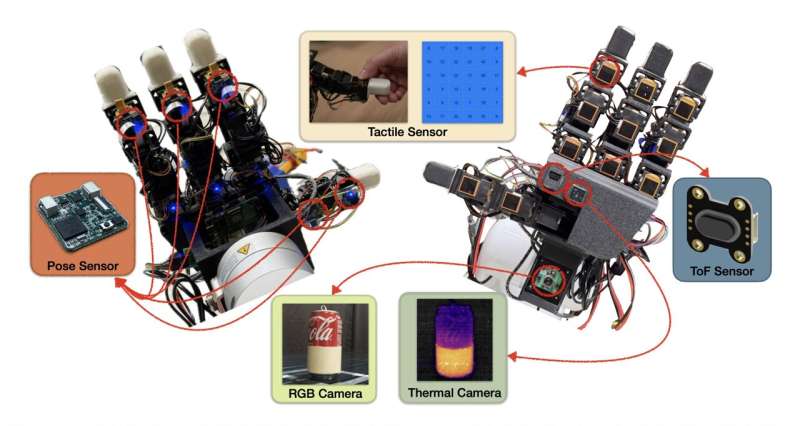
While roboticists have introduced increasingly advanced systems over the past decades, most existing robots are not yet able to manipulate objects with the same dexterity and sensing ability as humans. This, in turn, adversely impacts their performance in various real-world tasks, ranging from household chores to the clearing of rubble after natural disasters and the assembly or performing maintenance tasks, particularly in high-temperature working environments such as steel mills and foundries, where elevated temperatures can significantly degrade performance and compromise the precision required for safe operations.
Researchers at the University of Southern California recently developed the MOTIF (Multimodal Observation with Thermal, Inertial, and Force sensors) hand, a new robotic hand that could improve the object manipulation capabilities of humanoid robots. The innovation, presented in a paper posted to the arXiv preprint server, features a combination of sensing devices, including tactile sensors, a depth sensor, a thermal camera, inertial measurement unit (IMU) sensors and a visual sensor.
“Our paper emerged from the need to advance robotic manipulation beyond traditional visual and tactile sensing,” Daniel Seita, Hanyang Zhou, Wenhao Liu, and Haozhe Lou told Tech Xplore. “Current multi-fingered robotic hands often lack the integrated sensing capabilities necessary for complex tasks involving thermal awareness and responsive contact feedback.”
The main objective of the recent study by Seita and his students was to develop a new versatile and multimodal robotic hand inspired by human hands, which could handle objects both safely and precisely. By utilizing more comprehensive sensor input, the hand they created could perform more nuanced object interactions across various environments, from households to factories.
“The most intuitive thought at the beginning is exploring how to properly design systems that more closely align with human daily perceptual experiences. We were inspired by human behavioral activities,” Zhou and Liu explained.
“We used several commercially available robotic dexterous hands before. We realized that many existing hardware designs focus on mechanical transmission structures, and the products we could directly purchase did not meet our sensing requirements for many of our research ideas. This experience pushed us to seek a DIY-extensible hardware platform that would allow us to design and improve devices according to our own vision.
“The MOTIF hand is an advanced robotic hand that integrates several sensors—thermal, depth, RGB (visual), inertial (IMU), and tactile—onto a single dexterous platform,” explained the research team. “It extends the widely used LEAP hand design, providing enhanced sensing capabilities. Its key advantages include comprehensive environmental awareness, the ability to safely handle hot objects, and differentiation between objects of similar appearance but different physical properties.”

To evaluate the potential of the MOTIF hand, the researchers carried out two distinct experiments in a laboratory setting. The first experiment was designed to assess the hand’s ability to grasp objects while considering their temperature, to avoid touching particularly hot regions on their surface.
The second experiment entailed the manipulation of objects with the same shape but with different weights. To classify the mass of objects, the hand performed simple fingertip flick motions while handling them.
“The most notable achievement of our study is the integration of diverse sensors into a single dexterous robotic hand, significantly enhancing its manipulation capabilities,” said Lou. “Our findings show that thermal sensing combined with 3D reconstruction effectively guides safe grasping, and inertial sensing allows precise mass classification of objects.”
In initial tests, the robotic hand introduced by this team of researchers performed remarkably well, safely grasping various objects while also predicting their mass with good accuracy. In the future, MOTIF hand could be improved further and tested in a wider range of experiments to validate its potential for specific applications.
Seita and his students think that it could be particularly promising for tackling manual tasks in household environments, professional kitchens, and industrial settings. As the hand can safely handle hot objects and manipulate them with good precision, it could outperform other existing systems when cooking hot dishes, but also when welding or tightening screws, as these tasks require the accurate estimation of forces and the adaptation of manipulation strategies based on an object’s temperature.
“In the future, we plan to enhance the MOTIF hand further by integrating additional high-resolution fingertip sensors (e.g., Digit 360) to provide even finer tactile feedback,” added Liu. “We also aim to refine our multimodal sensing algorithms and explore additional applications in complex real-world settings, such as advanced in-hand manipulation tasks and environments requiring sophisticated thermal and force-based interactions.”
“This paper introduces a platform system. We presented this work last week at the ISER 2025 conference in Santa Fe and exchanged our ideas with many great researchers. We really hope it will inspire the community to think about more sensing modalities in their research direction,” Zhou added.
Written for you by our author Ingrid Fadelli,
edited by Lisa Lock, and fact-checked and reviewed by Andrew Zinin—this article is the result of careful human work. We rely on readers like you to keep independent science journalism alive.
If this reporting matters to you,
please consider a donation (especially monthly).
You’ll get an ad-free account as a thank-you.
More information:
Hanyang Zhou et al, The MOTIF Hand: A Robotic Hand for Multimodal Observations with Thermal, Inertial, and Force Sensors, arXiv (2025). DOI: 10.48550/arxiv.2506.19201
arXiv
© 2025 Science X Network
Citation:
Dexterous robotic hand integrates thermal, inertial and force sensors (2025, July 17)
retrieved 17 July 2025
from https://techxplore.com/news/2025-07-dexterous-robotic-thermal-inertial-sensors.html
This document is subject to copyright. Apart from any fair dealing for the purpose of private study or research, no
part may be reproduced without the written permission. The content is provided for information purposes only.
